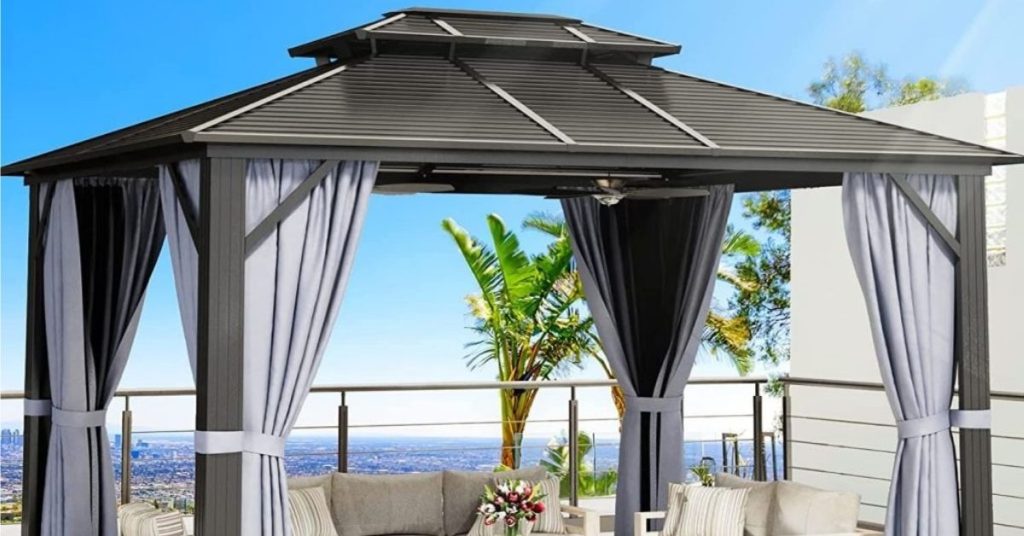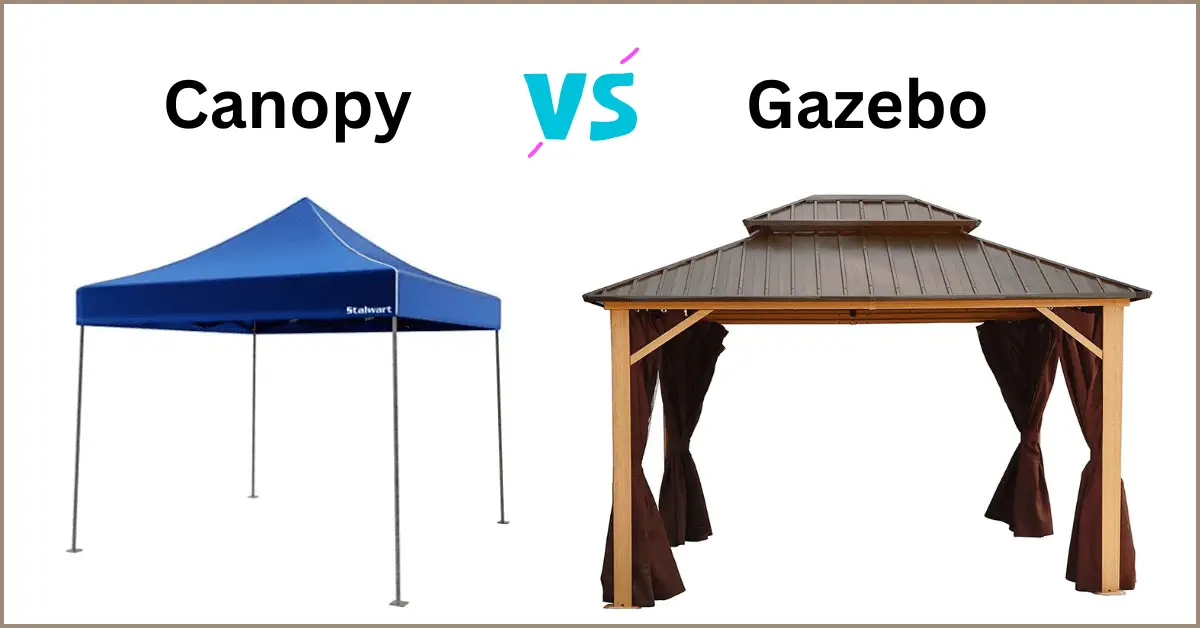Discover the ultimate showdown: Canopy vs Gazebo! Find out which one reigns supreme in providing shade, style, and relaxation.
Canopy Vs Gazebo
Finding the right shelter can make all the difference in enhancing your outdoor space. Two popular options for providing shade and protection are canopies and gazebos. While both serve similar purposes, they have distinct differences that may influence your decision.
This article aims to objectively analyze the key features and considerations when choosing between a canopy and a gazebo.
A canopy is a lightweight, portable structure typically made of fabric stretched over a frame. It offers temporary shelter and is commonly used for events or as a quick solution for sun protection.
On the other hand, a gazebo is a more substantial permanent fixture in the form of an open-sided pavilion with a roof. Gazebos often feature decorative elements designed for long-term use in outdoor spaces.
This article will compare canopies and gazebos in size, structure, portability, design features, weather resistance, versatility, cost considerations, and compatibility with different outdoor settings.
By objectively understanding these factors, readers can make an informed decision based on their specific needs and preferences when selecting these options for their outdoor space.
Canopy Vs Gazebo: Canopy and gazebo are outdoor shelters with key differences. Canopies are portable, lightweight, and easy to set up, perfect for quick shade. Gazebos are sturdier, more permanent structures, offering a solid retreat with added space and protection from the elements.
Definition and Purpose of a Canopy

A canopy is a protective covering, typically made of fabric or metal, designed to provide shade and shelter from the elements. It is a versatile structure used in various settings such as outdoor events, gardens, patios, and camping sites.
The primary purpose of a canopy is to shield individuals from direct sunlight, rain showers, and other weather conditions. Canopies are commonly constructed using durable materials like polyester fabric or sturdy metals such as aluminum or steel.
They often feature a lightweight design for easy setup and portability. Some canopies have additional features like sidewalls or mosquito nets to enhance protection against insects or wind gusts.
In addition to their functional aspects, canopies also offer aesthetic appeal. They come in different sizes, shapes, colors, and patterns to complement various outdoor environments. This makes them an attractive option for individuals who desire functionality and style.
Overall, canopies are crucial in creating comfortable outdoor spaces by providing shade and shelter. Whether used for social gatherings or personal relaxation time outdoors, they offer an essential solution for protection against the elements while adding beauty to any setting.
Definition and Purpose of a Gazebo
Gazebos are outdoor structures typically built in gardens, parks, or other open spaces, serving as a sheltered area for relaxation and social gatherings. These structures have been around for centuries, and their design varies across cultures and periods.
Here are some key features and purposes of a gazebo:
- Aesthetic Appeal: Gazebos often serve as focal points in gardens or parks due to their attractive design. They can add elegance and beauty to any outdoor space.
- Shelter from the Elements: One of the primary purposes of a gazebo is to provide shade from the sun, protection from rain showers, and refuge from strong winds. This allows individuals to enjoy the outdoors while being shielded from unfavorable weather conditions.
- Socializing Space: Gazebos offer an ideal setting for social gatherings such as parties, weddings, or picnics. Their open layout provides ample space for people to mingle and converse.
- Relaxation Oasis: Gazebo interiors can be furnished with comfortable seating arrangements, making them perfect relaxing spots. Whether reading a book or simply enjoying the surroundings, gazebos create a tranquil atmosphere conducive to unwinding.
Gazebos serve multiple purposes, from providing shelter and aesthetic appeal to facilitating social interactions and offering peaceful retreats.
Size and Structure Differences
Size and structure differences between gazebos can greatly vary depending on cultural influences and architectural styles.
Gazebos are freestanding structures that usually have an octagonal shape but can also be rectangular or oval. They are typically open on all sides, with a roof that provides shade and protection from the elements. The size of a gazebo can range from small garden structures to larger ones that can accommodate several people.
Regarding structure, gazebos often have pillars or columns supporting the roof, giving them a classical and elegant appearance. The materials used for construction also play a significant role in determining their overall look and feel.
Traditional gazebos are commonly made of wood, which adds warmth and natural beauty to the structure. However, modern versions may incorporate metal or vinyl for durability and low maintenance.
Cultural influences heavily impact the design and size of gazebos. For example, in Japanese gardens, you may find smaller pavilions known as teahouses where tea ceremonies occur. In contrast, Western-style gazebos tend to be larger and more ornate, often as focal points in formal gardens or public parks.
Whether small or large, simple or intricate in design, gazebos offer an inviting space for people to gather outdoors while enjoying shelter from the sun or rain.
Portability and Ease of Set-Up
Portability and ease of set-up are important factors when choosing a gazebo, as they allow for convenient installation and relocation without compromising its structural integrity.
Canopies and gazebos differ in their portability and ease of set-up due to variations in their design and construction.
Canopies are known for their lightweight nature, making them highly portable. They often come with a carrying bag or case, allowing easy transportation to different locations. Setting up a canopy is typically a straightforward process involving unfolding the frame, extending the legs, and securing the canopy fabric.
This simplicity makes canopies ideal for those requiring temporary shelter or shade in various settings, such as outdoor events or camping trips.
On the other hand, gazebos tend to be larger and more complex structures compared to canopies. While they may offer more stability and durability due to their sturdy frames and solid roofs, this also means that setting them up requires more time and effort.
Gazebos often involve assembling multiple parts like walls, roof panels, and support beams using screws or bolts. Although this might create challenges in portability, gazebos are designed for semi-permanent placement in gardens or outdoor spaces where regular relocation is unnecessary.
Canopies provide a portable solution that is easy to set up quickly while offering minimal structural complexity. Gazebos provide greater stability but require more laborious assembly due to their larger size and intricate design components.
The choice between these options ultimately depends on individual needs regarding convenience versus long-term placement.
Design and Aesthetic Features
Design and aesthetic features are crucial in creating an inviting outdoor space that seamlessly integrates with the surrounding environment. When comparing canopy and gazebo structures, it is important to consider their design and aesthetic qualities.
Canopies typically feature a more minimalist design, focusing on functionality rather than elaborate aesthetics. They are often made of lightweight materials such as polyester or nylon, allowing easy transportation and set-up. Canopies are available in various colors and patterns, allowing users to choose a design that complements their outdoor setting.
On the other hand, gazebos offer a more visually striking presence with their solid construction and ornate designs. They often feature intricate details such as decorative railings, pillars, and latticework. Gazebos can be made from wood or metal, providing durability and longevity. Their elegant appearance adds a touch of sophistication to any outdoor space.
Regarding integration with the surrounding environment, canopies blend in more effortlessly due to their simple design. However, gazebos can serve as focal points within a landscape, creating a sense of grandeur and drawing attention.
Choosing between a canopy and a gazebo depends on personal preference and the desired aesthetic impact on the outdoor space. Both options offer unique design elements that contribute to creating an inviting atmosphere outdoors.
Functionality in Different Weather Conditions
Functionality in different weather conditions is a crucial aspect to consider when selecting an outdoor structure, as it ensures the ability to enjoy the space comfortably and safely regardless of the elements.
Both canopies and gazebos offer some level of protection from various weather conditions, but their effectiveness differs.
Canopies are lightweight structures that provide temporary shelter from sun and light rain. They are typically made of fabric stretched over a metal frame and are easily portable. While they offer shade from the sun’s rays, they may not withstand strong winds or heavy rain.
Canopies are ideal for use during warm summer days or for short-term events where quick setup and takedown is required.
On the other hand, gazebos are more permanent structures that provide better protection against diverse weather conditions. They often have solid roofs made of wood or metal, offering shade and shelter from rain or snow.
Their sturdy construction allows gazebos to withstand harsher weather elements such as strong winds or heavy downpours.
While both canopies and gazebos serve as outdoor structures, their functionality in different weather conditions varies significantly. Canopies are suitable for temporary shade on sunny days or light showers, whereas gazebos offer more reliable protection against various weather elements throughout the year.
Versatility and Multi-Purpose Use

Versatility and multi-purpose use are important considerations when selecting an outdoor structure, as they allow for a wide range of activities and maximize the value of the space. When comparing canopy and gazebo structures in terms of versatility, there are several factors to consider.
- Customizability: Canopies often come in various sizes and styles, allowing for customization based on specific needs. Gazebo structures, on the other hand, offer a more permanent and fixed design that may limit customization options.
- Functionality: Canopies are lightweight and easy to transport, making them suitable for outdoor events such as picnics or beach outings. Gazebos provide a more solid structure with walls and a roof, offering better protection against wind, rain, or excessive sunlight.
- Multi-Purpose Use: Canopies can be used in different settings like parks or backyard gatherings due to their portability. They can serve as temporary shelters during camping trips or provide shade during outdoor sports events. Gazebos excel in creating a designated outdoor living space to accommodate furniture sets for relaxation or hosting social gatherings.
Both canopy and gazebo structures have their advantages regarding versatility and multi-purpose use. The choice ultimately depends on individual preferences and the intended purpose of the outdoor space.
Cost and Budget Considerations
When considering outdoor structures, one important factor is the cost and budget implications associated with each option. Both canopies and gazebos vary in price depending on size, material quality, and additional features. Canopies are generally more affordable than gazebos due to their simpler design and construction.
They are available at a wide range of prices, starting from around $50 for basic models of lightweight materials like polyester or nylon. On the other hand, gazebos tend to be pricier due to their sturdier build and more elaborate designs.
Gazebos can start at around $200 for smaller sizes made of metal or plastic materials, while larger wooden or aluminum gazebos can range from several hundred dollars up to thousands.
To provide a clearer comparison between canopy and gazebo prices, the following table presents three options for each structure type:
| Structure Type | Size (ft) | Price Range ($) |
|---|---|---|
| Canopy | 10×10 | 50-200 |
| 12×12 | 100-300 | |
| 15×15 | 150-500 | |
| Gazebo | 8×8 | 200-800 |
| 10×10 | 300-1,000 | |
| 12×12 | 500-2,000 |
Considering these price ranges and personal budget limitations, individuals can decide which option best suits their needs without compromising financial stability.
Choosing the Right Option for Your Outdoor Space

When considering cost and budget considerations, weighing the options between a canopy and a gazebo is important. However, once the financial aspect has been considered, choosing the right option for your outdoor space is crucial. This requires careful consideration of various factors such as functionality, aesthetics, and durability.
A canopy offers versatility and flexibility in terms of its usage. It can be easily set up and taken down, making it ideal for temporary or seasonal use. Canopies also provide ample shade and protection from the elements, allowing you to enjoy your outdoor space comfortably.
On the other hand, a gazebo provides a more permanent structure that adds an elegant touch to any outdoor setting. With sturdy construction and durable materials, pavilions offer long-term durability and withstand different weather conditions. They create a defined space within your outdoor area where you can relax or entertain guests.
Choosing between a canopy and a gazebo depends on your needs and preferences. Consider factors such as how often you will use the structure, the aesthetic appeal you desire for your outdoor space, and the level of permanence you seek.
By carefully evaluating these aspects, you can make an informed decision that suits your outdoor area’s budgetary constraints and aesthetic vision.
Canopy vs Gazebo
Canopies and gazebos are used for shelter but differ in design and purpose. Canopies are lightweight and portable, perfect for temporary shade at outdoor events.
In contrast, gazebos are more permanent structures, often made of wood or metal, creating a cozy space in gardens or parks. Choose a canopy for short-term shelter needs and a gazebo for a more long-term, sturdy outdoor setting.
Related Article: What is the Difference Between a Canopy, a Gazebo and a Pergola?
Frequently Asked Questions
Q.1 Are canopies and gazebos the same thing?
Canopies and gazebos are not the same thing. A canopy is a lightweight, portable shelter that provides shade or protection from rain. In contrast, a gazebo is a permanent outdoor structure with a roof and open sides, often used for relaxation or gatherings.
Q.2 Can I use a canopy or gazebo in a small outdoor space?
Both canopies and gazebos can be used in small outdoor spaces. Canopies are lightweight, portable structures that provide temporary shade, while gazebos are more permanent structures that offer a covered outdoor area for relaxation or entertainment.
Q.3 How long does it take to set up a canopy or gazebo?
The time it takes to set up a canopy or gazebo can vary depending on factors such as size, complexity of design, and familiarity with the assembly process. Generally, it can take anywhere from 10 minutes to a few hours.
Q.4 Can I customize the design of a canopy or gazebo?
Yes, both canopies and gazebos can be customized to fit individual preferences. Options for customization include choosing the size, shape, materials, colors, and additional features such as curtains or sidewalls.
Q.5 Are canopies and gazebos suitable for use in extreme weather conditions?
Both canopies and gazebos can be suitable for use in extreme weather conditions. However, their effectiveness depends on material quality, design features (e.g., reinforced frames), and proper installation to ensure stability and durability against harsh elements.
Conclusion
In conclusion, when comparing canopies and gazebos, it is evident that both have their unique features and purposes. Canopies are lightweight, portable, and temporarily shelter from the sun or rain.
On the other hand, gazebos are more permanent structures that offer a larger covered area for outdoor activities.
The choice between the two ultimately depends on size requirements, budget considerations, aesthetic preferences, and intended use.
By carefully considering these aspects, individuals can select the option that best suits their needs for their outdoor space.

